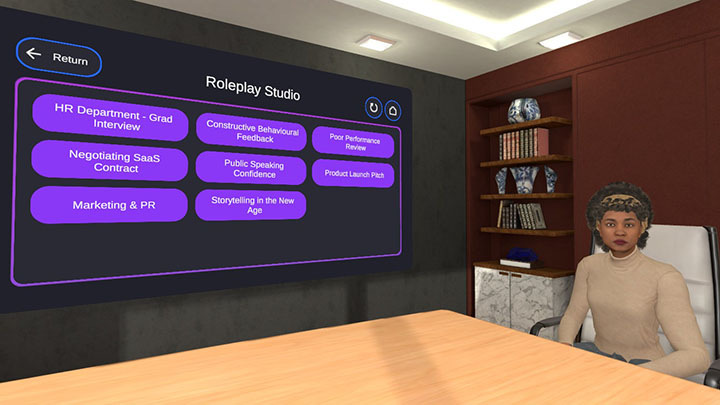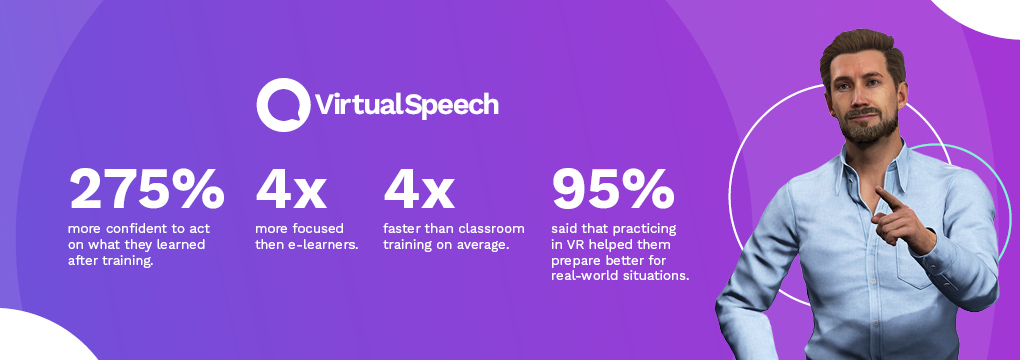In recent years, Virtual Reality (VR) in the corporate world has taken a foothold. Figures from PwC suggest that by 2022, the industry had grown by 76% from 2016 and reached a value of £801 million (approx. US $1000 million).
As VR continues to be adopted by the mainstream, it is no longer considered an emerging tech fad. Thanks to greater accessibility, many companies are now embracing VR to deliver employee training in a virtual environment.
This article explores some of the key benefits of using VR to enhance soft skill training in the corporate context.
Overview
Soft skills have typically been learnt on the job, through interactions with colleagues, clients and other stakeholders. Training people in soft skills is hard because people behave differently in similar situations, so a “one size fits all” approach isn’t very effective.
Practicing these skills in virtual reality (VR) can provide the bespoke experience employees need to develop soft skills. For example, without VR, how do employees practice giving a presentation to directors? Delivering a sales pitch to new clients? Being ambushed by the media? Laying off employees?
What is virtual reality?
Virtual reality is the term used to describe a three-dimensional environment that can typically be explored and interacted with by a user. When the user puts on a VR headset, they are completely immersed in this virtual world.
People tend to associate VR with gaming, but the possibilities of VR extend far beyond that. VR is now being used in healthcare, real estate, marketing, and corporate training to name just a few. For example, someone can put on a VR headset and be immersed in a virtual conference room, where they can practice giving a speech to an audience, providing a more realistic and effective way of practicing than to a colleague or in front of a mirror.
- Read more about VR Applications: Key Industries already using VR

Results of a soft skills training in VR study, conducted by PWC. Learners in VR were:
- 275% more confident to act on what they learned
- 4x faster than classroom training on average
- 4x more focused than e-learners
- 3.75x more emotionally connected to the content than classroom learners
Furthermore, our clients have reported an impressive 25% skill improvement after just 10 minutes of practicing in VR.
How can VR help develop soft skills?
Virtual reality can bridge the gap between online classes and traditional face-to-face training. The unique difference is that it enables learners to practice different business scenarios in a realistic way, so that they are more prepared when facing similar scenarios in the workplace.
For example, let’s say an employee wants to practice giving difficult feedback to a colleague for an upcoming yearly performance review. They could put on the VR headset and be transported to a virtual meeting room with the colleague as a virtual avatar. They can then practice delivering the feedback and the avatar can react to what is being said by picking out specific keywords from what the user has said and linking these with pre-loaded replies.
With advances in AI, speech-to-text and text-to-speech technologies, users are now able to have conversations with the avatars, with the avatars reacting to what is being said in real-time, as a real colleague would.

A user practicing roleplays with an AI-powered avatar.
Immersive learning
Immersive learning stands at the forefront of VR-based training, revolutionizing the development of soft skills. Through this immersive approach, learners gain the unique opportunity to actively engage with lifelike scenarios, honing essential skills such as effective communication, leadership, and emotional intelligence.
In a virtual environment, they navigate complex workplace situations, receiving real-time feedback and fine-tuning their abilities with precision.
Immersive learning seamlessly bridges the gap between theoretical knowledge and practical application, offering a secure and engaging space for employees to cultivate their soft skills.
It represents an indispensable tool in the modern corporate training landscape, effectively transforming the way individuals acquire and refine their abilities.
Continuous feedback and improvement
Feedback is a vital part of improving a skill. With the example given above, the user has a conversation with the avatar and can be given instant feedback on their performance, giving them areas to focus on when they repeat the exercise. Learning managers can also assess the capabilities of their employees (before and after the training), something which is typically very hard to do with soft skills.
Customization and on-demand training
Customization is key in soft skills development. VR allows organizations to tailor training modules to specific needs, creating an on-demand training environment that adapts to individual skill gaps.
For instance, at VirtualSpeech, we replicated the Vodafone UK Pavilion in VR to facilitate the practice of presentation skills during their Learning Week and beyond.
Within this virtual realm, employees can immerse themselves in various simulated environments, upload their own presentation slides and notes, and seamlessly receive instant automated feedback.
Beyond large-scale custom simulations, we also offer custom prompts for organizations in our roleplay rooms, enabling companies to design scenarios specific to their industry, organizational culture, or team dynamics. These customized roleplays allow employees to practice real-world interactions that they are likely to encounter, from difficult conversations with clients to negotiation tactics. The roleplays are also available in 12+ languages, allowing for a truly global reach. This ensures that employees across different regions can access training in their native language, enhancing comprehension and engagement.
Cost-effective at scale
If organizations choose to create content and develop bespoke VR experiences, the initial costs of building a VR course can be high.
However, when using VR, the return on investment (ROI), becomes more favorable in the medium and long term, because the delivery of VR training takes less time than classroom and e-learning courses, according to Deloitte Insights.
Organizations can also go with off-the-shelf solutions, where the VR content has been pre-developed. This works particularly well for soft skills training, where the training modules are similar across organizations. VirtualSpeech, for example, offers pre-built VR training across a range of soft skills, from Leadership Communication to High-Impact Presentations.
Once embedded throughout the organization, VR becomes an attractive investment, especially when considering the cost of employees’ time and the potential to scale across larger workforces. Greater scaling is possible when VR training is cloud-based, as geographical limitations become redundant. A defendable ROI can be achieved effortlessly, as the benefits of the training spend increase.

Training costs by type, from the same study.
Kyle Jackson, CEO, and co-founder of Talespin, an immersive training start-up, opines:
VR is consistently more cost-effective than other modalities when it’s used for about 1,500 employees. Factors [contributing] to this cost-benefit include reduced time to proficiency and reduced time to train because learners are taking in so much, and true retention happens much faster… In our rollouts, we have seen substantial gains in retention, confidence, learner satisfaction, and decision-making accuracy, among other metrics.
The picture becomes even more promising as VR technology continues to improve and it becomes easier and more affordable to implement. As the amount of hardware needed to run VR software lessens, the associated costs also drop, which has been evident in recent years. The latest VR systems are now self-contained, amazingly easy to assemble, and can be shipped out to any global location.
Consequently, in comparison to traditional modalities VR is more cost-effective at scale and allows enterprises to save money in the long term. This makes VR an appealing feature of any ongoing training strategy.
Faster training and more focused employees
It is noted that employees using VR complete training faster than those using traditional classroom and e-learning environments.
Employees were trained 3-4 times faster in VR compared to the classroom and 1.5 times faster than e-learning, according to training reports by VirtualSpeech and PwC. These results even consider the additional time needed to onboard new users with VR headsets for the first time (which was on average only 10 minutes).
Another favorable aspect of this technology is that users are less distracted during VR training due to its immersive nature. The VR headsets provide simulations that command the users to complete visual and auditory attention.
VR-trained learners were up to four times more focused during training than their e-learning peers, and 1.5 times more focused than their classroom peers.
More confident employees
Numerous studies have concluded that users trained with VR were more confident to act on what they learned after receiving soft skill training in VR, compared to other types of training. VirtualSpeech found that 86% of people trained felt more confident afterwards, and that 95% said that practicing in VR helped them prepare better for real-world situations. This is important as confidence is a critical driver of success, particularly in relation to soft skills.
The self-belief generated through effective VR training helps learners feel more connected, satisfied, and confident in applying what they have learnt.
VR training takes place in a safe environment where employees can practice dealing with difficult situations, which is especially useful for building confidence. For example, a sensitive meeting to manage poor performance could be practiced first in VR.
PwC noted, “40% greater improvement in confidence than classroom learners and 35% improvement over e-learners to act on what they learned after training in VR.”
Confidence, in turn, helps to build employee satisfaction. Therefore, it is no surprise that results from PwC indicate that 78% of all VR participants preferred v-learning to more traditional modalities. And 91% of the participants who took the classroom or e-learning course and then were given the option to take the v-learn course preferred the v-learn over both the classroom, and e-learning courses.
Greater satisfaction levels can lead to other desirable knock-on effects, as noted by VirtualSpeech when conducting after-training feedback surveys, such as higher employee retention levels, improvements in work quality, and a reduction in errors.
Additional benefits for soft skills development
Data capture and performance tracking
VR gives users and managers unprecedented behavioural data capture that provides systematic, objective, and highly unique insights into performance. This helps identify areas that need improving and helps to justify ROI, as managers can both measure and track progress made.
On-demand repetition
As we’ve already discussed, VR also lets users practice these soft skills from anywhere in the world, at any time. At VirtualSpeech, we’ve found that employees also repeat the VR training scenarios over several months, increasing knowledge retention and helping to overcome the Ebbinghaus Forgetting curve.
This repeated learning helps users become comfortable with soft skill scenarios and better able to deal with the same scenarios in the real world.
VR enables users to learn through experience, a topic we cover in more detail in our Experiential Learning with VR article. VR shifts the training away from passive learning towards actively working with new challenges and experiences.
Simulate randomness
VR can also simulate a range of random actions to occur, which the user needs to react to. An example of this is a media ambush scenario we’ve created, where the user starts in an elevator going down to a hotel lobby. The doors then open and the user is ambushed by a dozen press reporters, with cameras flashing and difficult questions being asked.
Independent practice
An overlooked benefit of this type of training is that the user can practice independently. Often, with soft skills, people need to verbally communicate and may not feel comfortable fully committing to the training with other people around them listening. This is particularly true at in-person training sessions, where role-play scenarios force participants to practice with other colleagues around them, often leaving people feeling uncomfortable.
We’ve also found that soft skills can be seen as a slightly embarrassing skill to want to improve. Unlike hard skills, which have to be learnt from scratch, there is a perception that we should automatically be good at soft skills – something that is not true for the majority of people.
Types of VR for soft skills development
VR can be broken up into several broad categories, all of which can be used to develop soft skills. Here’s an overview of these categories to give you an idea about the capabilities within VR training:
1. 360-degree videos
This is when a real room is filmed with a 360-degree camera, with real people being in the room as well. This type of training is great for complex situations where human emotions are required from the virtual avatars.
Face rigging and lip syncing technology are not quite good enough yet to truly simulate emotions on virtual avatars, so this is a good option for when realism is the main objective.
Use case examples: our emotional intelligence training uses 360-degree filming, as accurate human physical and verbal emotions are necessary from the avatar. With a 360-degree video, the avatar can be an actual human filmed with a 360-degree camera, ensuring that the emotions are accurate.

Emotional intelligence training, using a 360-degree camera to capture emotions and facial expressions.
2. Passive VR
Passive VR is when the user does not need to interact much with other people in the scene. This type of environment can be the most realistic, as the audience can be green-screened, non-reactive avatars and the environment highly rendered.
Use case examples: this type of VR is most suited when the audience is mostly passive, such as training for giving a presentation in a large conference hall.
3. Interactive VR
When the user does need a level of interaction with other people in the scene, but the emotions and animations of the avatar are not critical (otherwise, 360-degree filming is required). The VR needs to have mechanisms for the learner to interact with the scene, such as pushing buttons or selecting objects.
Use case examples: this type of training is suitable for practicing to lead a meeting, giving a sales pitch, and so on – essentially where the avatars need to react to what is being said.
Conclusion
Developing soft skills with VR is more effective than traditional training methods, as the VR industry is growing at a rapid rate, so is the capacity for VR soft skills training.
It is an important time to be involved. If your organization could benefit from VR training for soft skills, do not hesitate to get in contact with us to see how we can help your employees by using this exciting technology to develop their skills.




